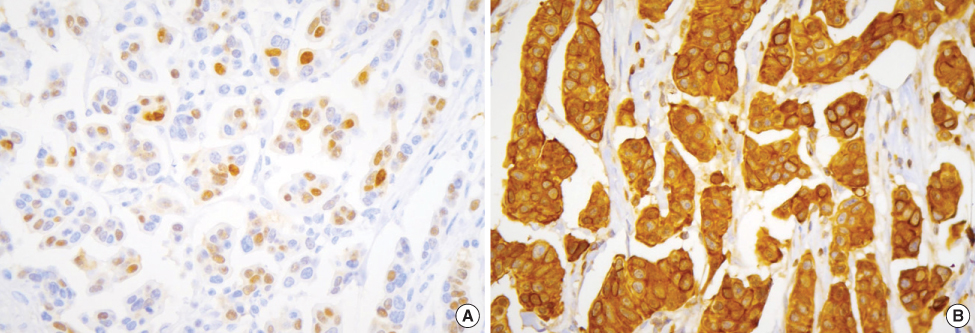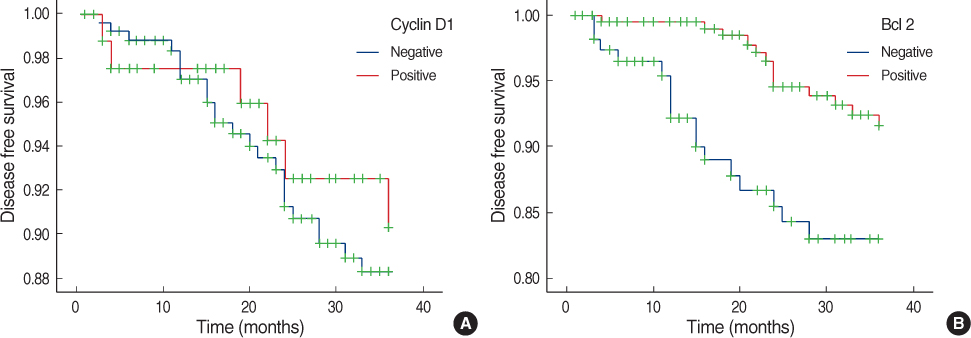J Breast Cancer.
2008 Dec;11(4):172-179. 10.4048/jbc.2008.11.4.172.
Expression of Cyclin D1 and bcl-2 in Infiltrative Ductal Carcinoma of the Breast: Their Correlations and Clinical implications
- Affiliations
-
- 1Department of Surgery, Hanyang University Hospital, College of Medicine, Seoul, Korea. acts123@hanmail.net
- 2Department of Pathology, Hanyang University Hospital, College of Medicine, Seoul, Korea.
- KMID: 2286582
- DOI: http://doi.org/10.4048/jbc.2008.11.4.172
Abstract
-
PURPOSE: Cyclin D1 and bcl-2 are involved in cell proliferation and apoptosis in tumor development and are commonly expressed in breast cancer. But there are few clinical reports on the correlation between cyclin D1 and bcl-2 expression. This study was designed to analyze the correlations of cyclin D1 and bcl-2 and their clinical implications in breast cancer.
METHODS
Immunohistochemical expression of cyclin D1 and bcl-2 were studied in 342 infiltrative ductal carcinoma cases and were compared with clinicopathologic parameters such as age, tumor size, histologic grade, lymph node status, p53, c-erbB2 and hormone receptors.
RESULTS
Cyclin D1 expression was found in 86 of 342 cases (25.1%). Bcl-2 was positive in 227 of 342 cases (66.4%). Bcl-2 overexpression was associated with the high expression of cyclin D1 (p=0.001). Correlation was detected between both cyclin D1 and bcl-2 and hormone receptor positivity (p<0.001). There was a reverse correlation between bcl-2 and histologic grade, p53, c-erbB2. And the bcl-2 overexpression group showed better disease free survival rates at 3-year follow up.
CONCLUSION
Higher expression of cyclin D1 was associated with bcl-2 overexpression. Positive estrogen receptor expression was associated with high cyclin D1 and bcl-2 expression. Bcl-2 tends to correlate with a positive clinical outcome.
Keyword
MeSH Terms
Figure
Cited by 1 articles
-
Different Prognostic Significance of Bcl-2 Based on Cancer Molecular Subtype
Ju-Young Lee, Hyun-Ah Kim, Eun-Kyu Kim, Hoe-Min Yang, Kwan-il Kim, Jong Inn Lee, Jae Soo Koh, Eunyoung Ko, Nan Mo Moon, Min-Suk Kim, Nam-Sun Paik, Woo Chul Noh
J Breast Cancer. 2011;14(Suppl 1):S10-S16. doi: 10.4048/jbc.2011.14.S.S10.
Reference
-
1. Dowdy SF, Hinds PW, Louie K, Reed SI, Amold A, Weinberg RA. Physical interaction of the retinoblastoma protein with human D cyclins. Cell. 1993. 73:499–511.
Article2. Bartkova J, Lukas J, Muller H, Lutzhoft D, Strauss M, Bartek J. Cyclin D1 expression and function in human breast cancer. Int J Cancer. 1994. 57:353–361.3. Zukerberg LR, Yang WI, Gadd M, Thor AD, Koerner FC, Schmidt EV, et al. Cyclin D1 (PRAD1) protein expression in breast cancer: approximately one-third of infiltrating mammary carcinomas show everexpression of the cyclin D1 oncogene. Mod Pathol. 1995. 8:560–567.4. Tsujimoto Y, Croce CM. Analysis of the structure, transcripts, and protein products of bcl-2, the gene involved in humjan follicular lymphoma. Proc Natl Acad Sci USA. 1986. 83:5214–5218.
Article5. Lu QL, Abel P, Foster CS, Lalani EN. Bcl-2: role in epithelial differentiation and oncogenesis. Human Pathol. 1996. 27:102–110.
Article6. Silvestrini R, Veneroni S, Daidone MG, Benini E, Boracchi P, Mezzetti M, et al. The bcl-2 protein: a prognostic indicator strongly related to p53 protein in lymph node-negative breast cancer patients. J Natl Cancer Inst. 1994. 86:499–504.
Article7. Zhang G, Tsuda H, Adachi I, Fukutomi T, Yamamoto H, Hirohashi S. Value of cancer-related oncoprotein expression as prognostic factors in breast cancers with one to three axillary lymph nodes positive. Jpn J Cancer Chemother. 1996. 23:66–74.8. Gee JM, Robertson JF, Ellis IO, Willsher P, McClelland RA, Hoyle HB, et al. Immunocytochemical localization of bcl-2 protein in human breast cancers and its relationship to a series of prognostic markers and response to endocrine therapy. Int J Cancer. 1994. 59:619–628.
Article9. Joensuu H, Pylkkanen L, Toikkanen S. Bcl-2 protein expression and long-term survival in breast cancer. Am J Pathol. 1994. 145:1191–1198.10. Lin HM, Lee YJ, Li G, Pestell RG, Kim HR. Bcl-2 induces cyclin D1 promoter activity in human breast epithelial cells independent of cell anchorage. Cell death Differ. 2001. 8:44–50.
Article11. Arýkök AT, Önal BÜ, Han Ü. Expressions of cyclin D1, p53, bcl-2, and bax in infiltrative ductal carcinoma of the breast: correlations with clinicopathologic characteristics. Breast J. 2006. 12:391–392.
Article12. Zhang SY, Caamano J, Cooper F, Guo X, Klein-Szanto AJ. Immunohistochemistry of cyclin D1 in human breast cancer. Am J Clin Pathol. 1994. 102:695–698.
Article13. van Diest PJ, Michalides RJ, Jannink L, van der Valk P, Peterse HL, de Jong JS, et al. Cyclin D1 expression in invasive breast cancer. Correlations and prognostic value. Am J Pathol. 1997. 150:705–711.14. Musgrove EA, Hamilton JA, Lee CS, Sweeney KJ, Watts CK, Sutherland RL. Growth factor steroid and steroid antagonist regulation of cyclin gene expression associated with changes in T-47D human breast cancer cell cycli progression. Mol Cell Biol. 1993. 13:3577–3587.
Article15. Lim SC. Role of COX-2, VEGF and cyclin D1 in mammary infiltrating duct carcinoma. Oncol Rep. 2003. 10:1241–1249.
Article16. Lebeau A, Unholzer A, Amann G, Kronawitter M, Bauerfeind I, Sendelhofert A, et al. EGFR, HER-2/neu, cyclin D1, p21 and p53 in correlation to cell proliferation and steroid hormone receptor status in ductal carcinoma in situ of the breast. Breast Cancer Res Treat. 2003. 79:187–198.
Article17. Hwang TS, Han HS, Hong YC, Lee HJ, Paik NS. Prognostic value of combined analysis of cyclin D1 and estrogen receptor status in breast cancer patients. Pathol Int. 2003. 53:74–80.
Article18. Michalides R, Hageman P, van Tinteren H, Houben L, Wientjens E, Klompmaker R, et al. A clinicopathological study on overexpression of cyclin D1 and p53 in a series of 248 patients with operable breast cancer. Br J Cancer. 1996. 73:728–734.
Article19. Leek RD, Kaklamanis L, Pezzela F, Gatter KC, Harris AL. Bcl-2 in normal human breast and carcinoma, associated with estrogen receptor-positive, epidermal growth factor-negative tumors and in situ cancer. Br J Cancer. 1994. 69:135–139.
Article20. Park SH, Kim H, Song BJ. Down regulation of bcl2 expression in invasive ductal carcinomas is both estrogen- and progesterone-receptor dependent and associated with poor prognostic factors. Pathol Oncol Res. 2002. 8:26–30.
Article21. Kang HJ, Kim SW, Yun YK, Oh SK, Choe KJ, Noh DY. Expression of p53, c-erbB2, bcl-2, cathepsin D in infiltrating ductal carcinoma of the breast. J Breast Cancer. 2001. 4:144–151.
Article22. Wang TT, Phang JM. Effects of estrogen on apoptotic pathways in human breast cancer cell line MCF-7. Cancer Res. 1995. 55:2487–2489.23. Haldar S, Negrini M, Monne M, Sabbioni S, Croce CM. Down regulation of bcl-2 by p53 in breast cancer cells. Cancer Res. 1994. 54:2095–2097.24. Hellemans P, van Dam PA, Weyler J, van Oosterom AT, Buytaert P, van Marck E. Prognostic value of bcl-2 expression in invasive breast cancer. Br J Cancer. 1995. 72:354–360.
Article25. Pezzella F, Turley H, Kuzu I, Tungekar MF, Dunnill MS, Pierce CB, et al. Bcl-2 protein in non-small-cell lung carcinoma. N Engl J Med. 1993. 329:690–694.
Article26. Hurlimann J, Larrinaga B, Vala DL. Bcl-2 protein in invasive ductal breast carcinomas. Virchows Arch. 1995. 426:163–168.
Article
- Full Text Links
- Actions
-
Cited
- CITED
-
- Close
- Share
- Similar articles
-
- Significance of Expression of bcl-2, p53 and cyclin D1 and Their Correlation with Clinicopathologic Prognostic Factors and Survival Rate in 128 Cases of Invasive Breast Carcinoma
- Expression of p27kip1, Cyclin D1 and p53 Protein in Ductal Carcinoma In Situ of the Breast
- Cyclin D1 Expression in 101 Cases of Breast Carcinoma
- Expression of Cyclin D1 and Bcl-xL in Basal Cell Carcinoma and Squamous Cell Carcinoma
- Expression of Anaphase Promoting Complex (APC) and APC Regulatory Proteins in Invasive Ductal Carcinoma Associated with Paget's Disease




